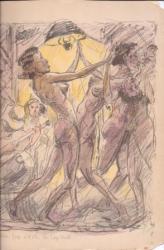
Tribal peoples of three continents: 1930s illustrations by Pier Antonio Gariazzo
80 lithographic prints, mostly hand-coloured, of drawings of indigenous peoples and tribal groups, made on a voyage to South America, Africa and Asia in 1933 by the Italian painter and film director Pier Antonio Gariazzo. With accompanying French letterpress. This collection of accomplished and beautifully-finished prints is a puzzle, with no apparent reference to it or to the letterpress among Gariazzo's published works.Each print on one side of a separate piece of thick laid paper, 24.5 x 32.5 cm. Numbered 1 to 82, with 61 and 63 lacking. All but a handful of the prints are in coloured wash. Each print carries a facsimile signature and caption in French in Gariazzo's hand. The letterpress consists of 44 pp on eleven loose bifoliums, on the same paper of the same dimensions as the prints. On aged paper, with some wear to corners, but mostly in good condition, and suitable for framing. One print [18], a beautifully-coloured representation of Bora Bora, has an unobtrusive central vertical fold, and written on the back by Gariazzo in large letters is 'ATTENTION | ! | VERRE CASSÉ - | (Ça coupe . . .)'.The images in this collection are striking, original and attractive, from the first print, which shows a 'petite fête a l'île de Cap Vert', consisting of four naked black women dancing lasciviously while a band of white men look on, to the last, showing an African tribesman, in leopardskin, pulling a long bow. There are also a number of exquisitely coloured land- and riverscapes (for example one captioned 'L'Ile de Motane - les îles sont habitées seulement par des oiseaux'). The portraits of the individuals are full of character ('Foutatoukaki est le dernier Cannibal de l'île Tabouaka 101 an . . . GARIAZZO Takuata 1933') and Gariazzo shows a keen eye for masculine authority and feminine beauty, with imposing tribal chiefs and bare-chested women. Individuals and groups are also shown at prayer, work (' - Toulon | la fabrication du vase on doit pas parler quand on fabrique une vase . . . les mauvais esprits s'y logeraient pour toujours') and dance (for example exquisite images of Balinese dancers and a polynesian tribal war dance).At once a painter, printmaker, film director and writer, Pier Antonio Gariazzo [Pietro Antonio Paolo Gariazzo] (1879-1964) is curiously neglected for one who excelled in so many fields. Together with the Belgian Daniele Plucker, he founded Savoia Films in his native city of Turin. Active between 1911 and 1918, the company worked with an impressive array of notable figures in the Italian film industry of the period (Nino Oxilia was a close friend). His 1918 work Teatro Muto promoted the ideas of the French philospher Henri Bergson. According to Angela Dalle Vacche, Gariazzo 'dabbled in philosophy, loved adventure, and traveled extensively (his experiences in Indonesia inspir[ing] several paintings)'.The illustrations reflect this love of adventure, depicting individuals and scenes from Cap Vert, Senegal [1]; Brazil (Tapajoz, rio Arari, Amazon) [2-17]; French Polynesia (Fakarava, Tahiti, Bora Bora, Moorea) [18-26]; Samoa and Fiji [27-32]; Rennell Island, Solomon Islands [33]; Toulon Island [34-39]; Isle of Pines (New Caledonia), Fiji, New Guinea [40-47]; Bali [48-67]; Java [68-70]; Singapore [71-72]; Ceylon [73]; Aden [74-75]; East Africa [76-82].The accompanying text is an untitled and unattributed meditative journal of the voyage in French. It is unpaginated, and there are clearly gaps, making it difficult to establish the sequence of the eleven signatures. It begins, on the only signature with a coloured initial, with 'Novembre [1932]': 'Nous glissons sur la courbe du monde. Le temps et la mer sont sans couleur. Des souvenirs de nos vieux pays, - nostalgies, - mélancolies, - images de femmes, - refrain de musique, - ronflement de machine, - odeur d'huile chaude, sont avec nous sur ce petit bateau.' The narrator travels from Spain through Gibraltar. There is then a gap, and he is in Brazil, his route following the sequence of the prints: in August he is in Tahiti (6 pp), and at the end of September in Bali (8 pp). On the last page it is November [1933] and he is in Ostende: 'Le voyage est fini. | Le soleil est loin... au sud, plus au sud.'Bearing in mind his admiration for Bergson, one may assume that the author of the text is Gariazzo himself. Whatever the identity of the author, it is an effective and evocative meditation, as the following indicates:'Cette question de l'âme est délicate: l'âme est une chose très fragile. La mauvaise humeur, la maladie, les passions, risquent toujours de la détacher du corps. Un homme ne doit même pas désirer trop ardemment une belle fille, son âme pourrait courir après son désir et le laisser tout seul ici-bas. Ce précepte est sage, car à Bâli, beaucoup d'hommes risque- [new signature] raient de perdre leur âme devant ces théories féminines, où comme dans une frise décorative polychromée, passent rieuses et saines ces fleurs de la vie.' NO OTHER COPY TRACED.


